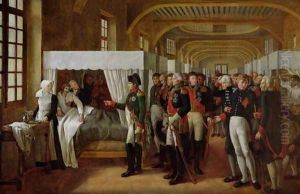Alexandre Veron-Bellecourt Paintings
Alexandre Veron-Bellecourt was a French painter born in 1823. His work is often associated with the Barbizon school, a group of artists who worked in the village of Barbizon near the Forest of Fontainebleau in France. These artists, including Jean-François Millet and Théodore Rousseau, among others, were known for their realistic and naturalistic representations of rural life and landscape, a style which Veron-Bellecourt also embraced in his paintings.
Veron-Bellecourt's early education and influences are not as well-documented as some of his contemporaries, but it is known that he was active during a time when the Barbizon school was challenging the formal traditions of the French Academy. He would have been part of the movement towards plein air painting, where artists would paint outdoors to capture the transient effects of light and atmosphere, a practice that was revolutionary at the time and would later heavily influence the Impressionists.
Throughout his career, Veron-Bellecourt exhibited his work at the Paris Salon, the official art exhibition of the Académie des Beaux-Arts in Paris. This was the primary method for artists to gain recognition during that era. His paintings often depicted the French countryside, agricultural workers, and rustic scenes that communicated a sense of serenity and the beauty of simple life. His approach to painting emphasized mood and the quality of light, with a subdued palette and loose brushwork that suggested rather than detailed the subjects.
Veron-Bellecourt's contribution to art was significant during his lifetime, but unlike some of his peers, his legacy did not have the same enduring impact, and his name is not as widely recognized as other Barbizon painters or the Impressionists who followed. Nevertheless, his work is valued for its place within the context of the Barbizon school's contributions to the development of modern art.
He passed away in 1900, leaving behind a body of work that captured the tranquil essence of the French countryside. Today, his works are held in private collections and occasionally appear in auctions. They serve as a testament to the Barbizon school's artistic philosophy and its role in the evolution of landscape painting.
